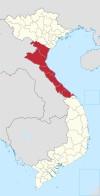Thái Hòa
You can help expand this article with text translated from the corresponding article in Vietnamese. (October 2023) Click [show] for important translation instructions.
|
Thái Hòa
Thị xã Thái Hòa | |
|---|---|
Nghệ An | |
| Established | 15 November 2007 |
| Area | |
| • Total | 135.188 km2 (52.196 sq mi) |
| Population | |
| • Total | 70,870 |
| • Density | 498.7/km2 (1,292/sq mi) |
| (2018) | |
| Time zone | UTC+07:00 (Indochina Time) |
Thái Hòa is a
Geography
Thái Hòa has a border with
Thái Hòa is a hilly district. Lowlands and valleys make up only around 30% of the area, while hills make up 60% and mountains 10%. However, the terrain is still flat enough to be advantageous for the widespread development of agriculture. Some of the soil is suitable for growing high value cash crops such as coffee, rubber, tea, and fruits.
10152ha out of 13518ha of the district's land are used for agriculture. 307ha are unused.
Con River flows through the town as well as two of the southern communes of the district.[2]
Climate
| Climate data for Tây Hiếu, Thái Hòa District | |||||||||||||
|---|---|---|---|---|---|---|---|---|---|---|---|---|---|
| Month | Jan | Feb | Mar | Apr | May | Jun | Jul | Aug | Sep | Oct | Nov | Dec | Year |
| Record high °C (°F) | 35.7 (96.3) |
36.5 (97.7) |
39.6 (103.3) |
43.0 (109.4) |
42.0 (107.6) |
41.6 (106.9) |
41.3 (106.3) |
39.9 (103.8) |
37.3 (99.1) |
35.9 (96.6) |
36.5 (97.7) |
38.5 (101.3) |
43.0 (109.4) |
| Mean daily maximum °C (°F) | 21.2 (70.2) |
22.2 (72.0) |
25.2 (77.4) |
30.0 (86.0) |
33.4 (92.1) |
34.2 (93.6) |
34.2 (93.6) |
32.8 (91.0) |
31.0 (87.8) |
28.6 (83.5) |
25.7 (78.3) |
22.7 (72.9) |
28.5 (83.3) |
| Daily mean °C (°F) | 17.0 (62.6) |
18.1 (64.6) |
20.7 (69.3) |
24.5 (76.1) |
27.5 (81.5) |
28.8 (83.8) |
28.8 (83.8) |
27.7 (81.9) |
26.4 (79.5) |
24.1 (75.4) |
21.1 (70.0) |
17.9 (64.2) |
23.6 (74.5) |
| Mean daily minimum °C (°F) | 14.4 (57.9) |
15.8 (60.4) |
18.2 (64.8) |
21.4 (70.5) |
23.9 (75.0) |
25.2 (77.4) |
25.2 (77.4) |
24.7 (76.5) |
23.6 (74.5) |
21.3 (70.3) |
18.1 (64.6) |
14.9 (58.8) |
20.6 (69.1) |
| Record low °C (°F) | 0.3 (32.5) |
3.7 (38.7) |
5.3 (41.5) |
11.4 (52.5) |
16.1 (61.0) |
18.9 (66.0) |
20.4 (68.7) |
20.3 (68.5) |
16.8 (62.2) |
11.4 (52.5) |
5.6 (42.1) |
0.2 (32.4) |
0.2 (32.4) |
| Average precipitation mm (inches) | 22.1 (0.87) |
20.7 (0.81) |
30.3 (1.19) |
61.6 (2.43) |
149.5 (5.89) |
166.2 (6.54) |
179.5 (7.07) |
266.7 (10.50) |
345.1 (13.59) |
269.4 (10.61) |
59.5 (2.34) |
21.7 (0.85) |
1,608.2 (63.31) |
| Average rainy days | 9.1 | 10.6 | 12.0 | 10.2 | 12.9 | 11.8 | 12.0 | 15.9 | 15.3 | 12.7 | 8.4 | 6.3 | 135.7 |
| Average relative humidity (%)
|
87.2 | 87.9 | 87.3 | 85.1 | 81.5 | 80.4 | 80.5 | 85.3 | 87.3 | 86.7 | 85.7 | 85.4 | 84.9 |
| Mean monthly sunshine hours | 76.2 | 56.5 | 69.2 | 122.1 | 190.2 | 179.1 | 193.3 | 162.0 | 145.2 | 132.5 | 109.1 | 90.2 | 1,533.8 |
| Source: Vietnam Institute for Building Science and Technology[3] | |||||||||||||
Demography
Thái Hòa has 67427 inhabitants, almost 500 per km2. 5751 are members of ethnic minorities, mainly Thanh, Thái, Thổ. 30750 are within working age and 35% of them involved in non-agricultural activities.
Administrative divisions
The districts includes four urban wards (phường) and 6 rural communes (xã):
- Quang Phong Ward
- Hoà Hiếu Ward
- Quang Tiến Ward
- Long Sơn Ward
- Nghĩa Hoà Commune
- Tây Hiếu Commune
- Nghĩa Mỹ Commune
- Nghĩa Thuận Commune
- Đông Hiếu Commune
- Nghĩa Tiến Commune
Economy
The structure of Thái Hòa's economy is as follows:
- Agriculture, forestry, fishery: 17.3%
- Industry, construction, mining: 30.2%
- Services: 52.5%
Infrastructure
Thái Hoà is at the intersection of two national roads. National Road 48 connects it to
There is also a branch of the
References
- ^ a b Decision No. 09, 12/02/2010 of the Government of Vietnam (in Vietnamese)
- ^ a b c d e Viet Nam Administrative Atlas. Cartographic Publishing House, Hanoi 2010
- ^ "Vietnam Institute for Building Science and Technology" (PDF). Retrieved 16 August 2023.
- ^ Vietnam Economic Times, Hung Van: "Thành phố" bò sữa Thái Hoà. 11.10.2010

